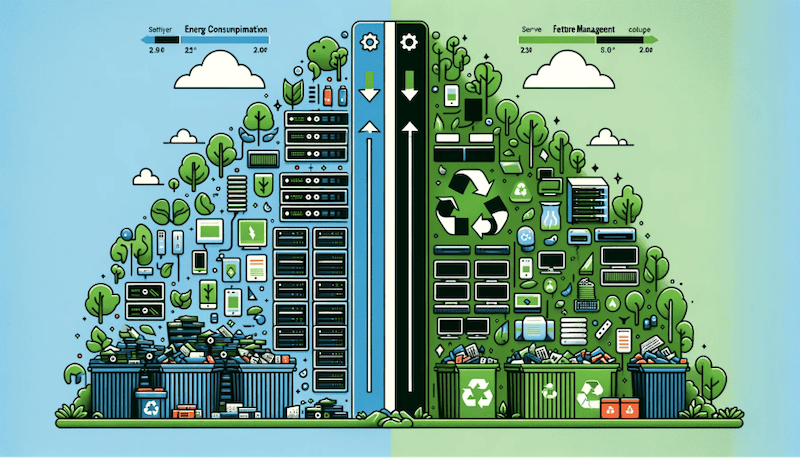The Environmental Impact of Feature Management
Nowadays, the issue of sustainability has moved from the fringes of public discourse to become a central concern for industries worldwide, and the technology sector is no exception. The significance of sustainability within the technology sector has escalated more than ever before.
As the digital era continues to evolve at a rapid pace, the environmental footprint of the tech industry has come under increasing scrutiny. This is primarily due to the vast amounts of energy and resources consumed by technology infrastructures such as data centers, networks, and the multitude of end-user devices that have become ubiquitous daily

As global awareness of environmental issues such as climate change, resource depletion, and carbon emissions intensifies, the tech industry finds itself at a crossroads. It is no longer just about innovation and development; there's a growing need to balance progress with sustainable practices and environmental stewardship.
The Growing Importance of Sustainability in Tech
With its large data centers, extensive network infrastructures, and billions of smart devices, the digital ecosystem has led to a significant increase in energy use and resource consumption in the tech sector. These developments, while beneficial in connecting the world and driving innovation, have a substantial environmental cost. The high energy demand for maintaining and operating these systems has heightened concerns about their carbon footprints and overall planetary impact.
In response, the tech industry is increasingly adopting sustainable practices. This change is driven by regulatory bodies, customer expectations, investor demands, and a genuine concern for the planet. Companies now realize that sustainable practices benefit the environment, their brand, customer loyalty, and their financial success.
This shift towards sustainability is taking various forms. Tech companies are designing energy-efficient data centers, using renewable energy, adopting eco-friendly manufacturing, and focusing on product recyclability. They aim to minimize their environmental impact through these diverse strategies.
Moreover, there's an emphasis on the entire lifecycle of software products. This includes not only their development but also their deployment, use, and management, focusing on improved resource management. This commitment to sustainability is crucial for creating a more environmentally responsible world.
How Feature Management Can Reduce Carbon Footprints

As we move forward, we see the future of technology is closely linked with our planet's health. Integrating sustainability into software development's core strategies and practices is becoming vital.
The Role of Feature Management in Sustainable Software Deployment
Feature management is a key strategy for mitigating environmental impact and achieving sustainable technology practices. It contributes to efficient and eco-friendly software deployment, making it crucial for greener technology practices.
Feature management strategically controls and deploys new features in software applications. Developers can release, test, and modify functionalities in a controlled, incremental manner. They can also phase them out to specific user segments. Its significance lies in optimizing the deployment process. This minimizes resource consumption and energy expenditure.
Traditionally, deployment strategies involve large, infrequent updates. These are resource-intensive in terms of energy and computational demand. They require significant resources and often lead to downtime. During this downtime, additional resources are consumed to bring systems back online.
Feature management allows for smaller, more frequent updates. This reduces the strain on servers and data centers. It leads to more efficient resource use and effecitvely reducing the carbon footprint of software deployments. Incremental changes reduce the need for extensive rollbacks and associated resource consumption, thereby diminishing environmental impact.
Enhancing Eco-Efficiency with Targeted and Adaptive Deployments
Feature management enables targeted deployments. Developers can selectively roll out features to specific segments or environments. This ensures judicious use of server capacities and avoids wasteful expenditure on unnecessary or underused features. It allows for precise server allocation and processing power, enhancing resource efficiency.
Feature management also reduces errors and bugs. Efficient practices allow for thorough testing and quicker issue resolution. This saves resources on fixing large-scale problems post-deployment. It saves energy and streamlines the development process, making it more environmentally friendly.
Beyond environmental benefits, feature management supports broader sustainability goals. It enables faster feature adaptation and responsiveness to user needs. This leads to efficient software that meets user requirements without overburdening the system. It contributes to the software lifecycle's longevity and sustainability, underscoring feature management's importance in sustainable technology practices.
Minimizing Resource Usage with Green A/B Testing

A/B testing is essential for optimizing and improving software applications. Yet, as environmental sustainability becomes more crucial, the conventional practices of A/B testing are being re-evaluated. The concept of Green A/B testing is aimed at minimizing the resource usage and environmental impact associated with these testing phases.
Traditional A/B testing compares different feature versions among user segments. It assesses which version performs better in user engagement, satisfaction, or other metrics. Although effective for enhancing user experience and product performance, this method often demands significant resources, traffic, and computational power. Each test variant typically runs on separate servers or instances, increasing energy use and carbon footprint.
Green A/B testing seeks to address these environmental concerns by incorporating eco-friendly practices into the testing process. It focuses on optimizing test designs to use fewer resources while maintaining result quality. For example, using advanced statistical methods to cut down on required tests and computational power.
Another aspect of Green A/B testing is the use of advanced AI algorithms and machine learning techniques to predict outcomes with fewer data points and a combination of highly efficient evaluation of a broad set of hypotheses within a single experiment. This predictive modeling allows for a reduction in the sample size needed for testing, thereby decreasing the overall computational load.
Environmental Benefits of Efficient Feature Management

The move towards efficient feature management in software development is not just a theoretical exercise in sustainability; it has tangible, real-world implications for the environment. Efficient feature management, at its core, revolves around deploying software updates and new features in a more controlled and resource-conscious manner.
This approach significantly reduces the frequency and volume of data transferred and processed during each update, leading to a direct decrease in energy use. In data centers and server farms, where energy consumption is a major environmental concern, this reduction is particularly impactful.
The environmental benefits extend beyond just energy savings. By minimizing the need for large-scale, all-encompassing updates, efficient feature management reduces the computational load on servers. This, in turn, translates into less heat generation and a lower demand for cooling, which is another major energy consumer in data centers.
Moreover, the reduced server load can prolong hardware lifespans, thereby decreasing the demand for new hardware production and the associated environmental costs. These metrics can be tracked over time to provide a clear picture of the environmental savings achieved through efficient feature management.
In addition to its direct impacts, the principles of efficient feature management can inspire broader changes within organizations, leading to a culture of sustainability that permeates other aspects of business operations. This shift can catalyze wider environmental initiatives, ranging from green procurement practices to investments in renewable energy sources.
Conclusion
This growing importance of sustainability in tech is not just a trend but a fundamental shift in how the industry operates and how it envisions its role in a global context. The role of feature management in reducing the carbon footprint of software deployments is multifaceted.
By enabling more controlled, efficient, and targeted deployment processes and experiments, feature management not only enhances the performance and reliability of software but also significantly reducing impact in the tech industry.
As the focus on sustainability continues to grow, the adoption of feature management practices becomes increasingly important in the journey towards greener and more responsible software development, which is proving to be an essential component in the tech industry's journey towards environmental responsibility.
ConfigCat is a feature flag and remote configuration service that empowers developers to control and customize the functionality of their applications. With ConfigCat, you can easily toggle features on and off, alter their settings, and roll out updates to specific users or groups. Targeting is supported through attributes, percentage-based rollouts, and segmentation. ConfigCat is available for all major programming languages and frameworks, and can be accessed as a SaaS or self-hosted service. Additionally, we are fully compliant with GDPR and ISO 27001 standards.
For more feature flagging goodies, stay connected to ConfigCat on X, Facebook, LinkedIn, and GitHub.
